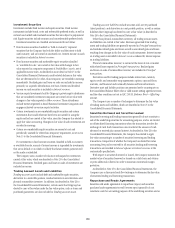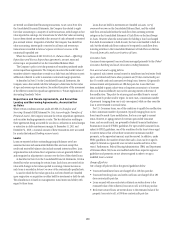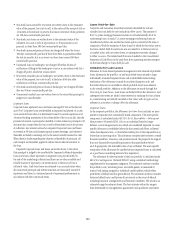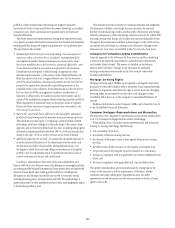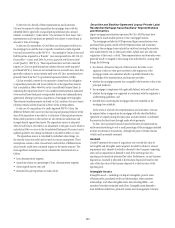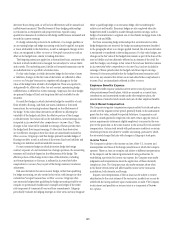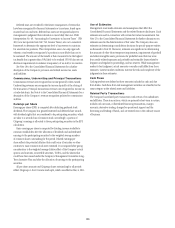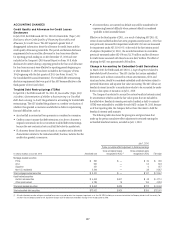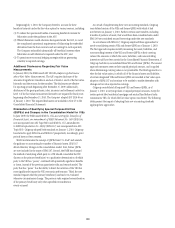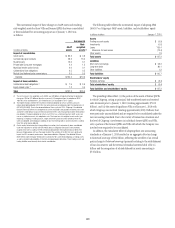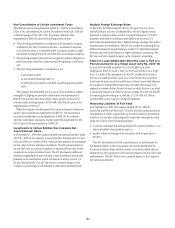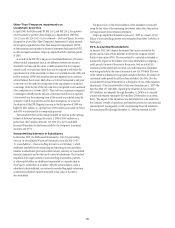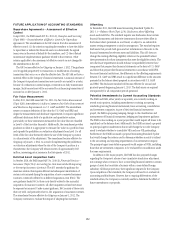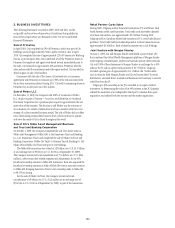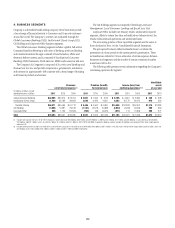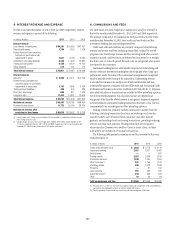Citibank 2011 Annual Report Download - page 169
Download and view the complete annual report
Please find page 169 of the 2011 Citibank annual report below. You can navigate through the pages in the report by either clicking on the pages listed below, or by using the keyword search tool below to find specific information within the annual report.
147
ACCOUNTING CHANGES
Credit Quality and Allowance for Credit Losses
Disclosures
In July 2010, the FASB issued ASU No. 2010-20, Receivables (Topic 310):
Disclosures about Credit Quality of Financing Receivables and
Allowance for Credit Losses. The ASU required a greater level of
disaggregated information about the allowance for credit losses and the
credit quality of financing receivables. The period-end balance disclosure
requirements for loans and the allowance for loan losses were effective
for reporting periods ending on or after December 15, 2010 and were
included in the Company’s 2010 Annual Report on Form 10-K, while
disclosures for activity during a reporting period in the loan and allowance
for loan losses accounts were effective for reporting periods beginning on
or after December 15, 2010 and were included in the Company’s Forms
10-Q beginning with the first quarter of 2011 (see Notes 16 and 17 to
the Consolidated Financial Statements). The troubled debt restructuring
disclosure requirements that were part of this ASU became effective in the
third quarter of 2011 (see below).
Troubled Debt Restructurings (TDRs)
In April 2011, the FASB issued ASU No. 2011-02, Receivables (Topic 310):
A Creditor’s Determination of whether a Restructuring is a Troubled
Debt Restructuring, to clarify the guidance for accounting for troubled debt
restructurings. The ASU clarified the guidance on a creditor’s evaluation of
whether it has granted a concession and whether a debtor is experiencing
financial difficulties, such as:
Any shortfall in contractual loan payments is considered a concession.
Creditors cannot assume that debt extensions at or above a borrower’s
original contractual rate do not constitute troubled debt restructurings
because the new contractual rate could still be below the market rate.
If a borrower doesn’t have access to funds at a market rate for debt with
characteristics similar to the restructured debt, that may indicate that the
creditor has granted a concession.
A borrower that is not currently in default may still be considered to be
experiencing financial difficulty when payment default is considered
“probable in the foreseeable future.”
Effective in the third quarter of 2011, as a result of adopting ASU 2011-02,
certain loans modified under short-term programs since January 1, 2011 that
were previously measured for impairment under ASC 450 are now measured
for impairment under ASC 310-10-35. At the end of the first interim period
of adoption (September 30, 2011), the recorded investment in receivables
previously measured under ASC 450 was $1,170 million and the allowance
for credit losses associated with those loans was $467 million. The effect of
adopting the ASU was approximately $60 million.
Change in Accounting for Embedded Credit Derivatives
In March 2010, the FASB issued ASU 2010-11, Scope Exception Related to
Embedded Credit Derivatives. The ASU clarifies that certain embedded
derivatives, such as those contained in certain securitizations, CDOs and
structured notes, should be considered embedded credit derivatives subject to
potential bifurcation and separate fair value accounting. The ASU allows any
beneficial interest issued by a securitization vehicle to be accounted for under
the fair value option at transition on July 1, 2010.
The Company has elected to account for certain beneficial interests issued
by securitization vehicles under the fair value option that are included in
the table below. Beneficial interests previously classified as held-to-maturity
(HTM) were reclassified to available-for-sale (AFS) on June 30, 2010, because
as of that reporting date, the Company did not have the intent to hold the
beneficial interests until maturity.
The following table also shows the gross gains and gross losses that
make up the pretax cumulative-effect adjustment to retained earnings for
reclassified beneficial interests, recorded on July 1, 2010:
*ULYææ
0RETAXæCUMULATIVEæEFFECTæADJUSTMENTæTOæ2ETAINEDæEARNINGS
In millions of dollars at June 30, 2010 !MORTIZEDæCOST
'ROSSæUNREALIZEDæLOSSESæ
RECOGNIZEDæINæ!/#)æ
'ROSSæUNREALIZEDæGAINSæ
RECOGNIZEDæINæ!/#) &AIRæVALUE
-ORTGAGEBACKEDæSECURITIESæ
0RIMEæ
!LT!æ
3UBPRIMEæ
.ON53æRESIDENTIALæ
4OTALæMORTGAGEBACKEDæSECURITIESæ
!SSETBACKEDæSECURITIESæ
!UCTIONæRATEæSECURITIES
/THERæASSETBACKED
4OTALæASSETBACKEDæSECURITIESæææææææææææææææææææææææææææææææææææææææææææææææææ
4OTALæRECLASSIFIEDæDEBTæSECURITIESæ
æ !LLæRECLASSIFIEDæDEBTæSECURITIESæWITHæGROSSæUNREALIZEDæLOSSESæWEREæASSESSEDæFORæOTHERTHANTEMPORARYIMPAIRMENTæASæOFæ*UNEæææINCLUDINGæANæASSESSMENTæOFæWHETHERæTHEæ#OMPANYæINTENDSæTOæSELLæTHEæSECURITYæ&ORæ
SECURITIESæTHATæTHEæ#OMPANYæINTENDSæTOæSELLæIMPAIRMENTæCHARGESæOFææMILLIONæWEREæRECORDEDæINæEARNINGSæINæTHEæSECONDæQUARTERæOFæ



